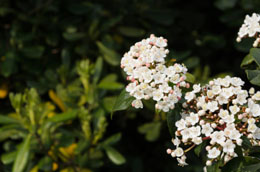Viburnum is a low maintenance shrub that not only looks good, but also smells heavenly. This write-up provides information on some of the varieties of this shrub.

The genus
Viburnum has more than 150 species that can be categorized into evergreen, semi-evergreen, and deciduous woody shrubs. Several species are native to North America. These are often used for landscaping due to their adaptability and versatile nature. Some of the varieties can be used as shrub borders, hedges, and screens; some of them work well as standalone ornamental trees. Besides the beautiful white and pink flowers that grow in dome-shaped clusters, these are also grown for their colorful fruits or berries. Some refer to these berries as ornamental fruits, as they come in a wide range of colors.
Varieties
There are several varieties that can be used for landscaping. These fast growing hedges can be trimmed and given various shapes. Pink buds blossom into beautiful flower clusters that are snowball-shaped. Several Asian varieties produce a heavenly scent. Korean spice viburnum is a variety that is very popular due to its sweet fragrance. Cayuga, Compactum, Mohawk, and Judd viburnum are other fragrant varieties. Arrowwood produce attractive foliage and bluish berries that come in clusters. Tea Viburnum is a deciduous variety that grows into a somewhat vase-like shape. It is known for its beautiful dark blue-green foliage, snowy white flowers, and reddish-orange berries.
Conditions Required for Growth
This shrub needs well-drained soil, full sun, and moderate watering to grow properly. This shrub can survive in partial shade. Moderately fertile soil with pH ranging from 5.6-6.6 works well for them, but these can even grow in alkaline soils.
Propagation
You could purchase the shrub from any nursery or garden center. You could also take a stem from a shrub and attach it to the ground using a U-shaped wire. Once it has rooted, you can replant it in your garden.
Pruning
Getting rid of dead or diseased stems and branches is extremely important. Use pruning shears to remove these dead parts. Also, prune the areas where stems are crossing over each other. Prune the branches after the blooms fade. Cut the oldest branches back at the crown, but always remember that you must never prune more than one-thirds of the bush.
Fertilizing
Apply a slow-release fertilizer in the spring. You must also be careful about the diseases that can affect this shrub. If the leaves are getting discolored, you must check for an aphid infestation. Aphids generally attack the tender branches and flower clusters. If the growth of the plant seems to be stunted and foliage looks yellow, it could be caused due to nematodes. Southern root knot nematodes can also cause a great deal of damage. Leaf spot fungi can also cause blotches on the leaves. Use pest control methods to avoid such problems.
The vibrant colors and sweet fragrance of the flowers and berries makes this shrub a must-have for your garden. Do follow the aforementioned tips, so that this shrub can grow properly.






 The genus Viburnum has more than 150 species that can be categorized into evergreen, semi-evergreen, and deciduous woody shrubs. Several species are native to North America. These are often used for landscaping due to their adaptability and versatile nature. Some of the varieties can be used as shrub borders, hedges, and screens; some of them work well as standalone ornamental trees. Besides the beautiful white and pink flowers that grow in dome-shaped clusters, these are also grown for their colorful fruits or berries. Some refer to these berries as ornamental fruits, as they come in a wide range of colors.
The genus Viburnum has more than 150 species that can be categorized into evergreen, semi-evergreen, and deciduous woody shrubs. Several species are native to North America. These are often used for landscaping due to their adaptability and versatile nature. Some of the varieties can be used as shrub borders, hedges, and screens; some of them work well as standalone ornamental trees. Besides the beautiful white and pink flowers that grow in dome-shaped clusters, these are also grown for their colorful fruits or berries. Some refer to these berries as ornamental fruits, as they come in a wide range of colors.